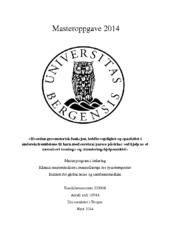| dc.contributor.author | Hansen, Hege Marie | en_US |
| dc.date.accessioned | 2015-01-16T14:23:56Z | |
| dc.date.available | 2015-01-16T14:23:56Z | |
| dc.date.issued | 2014-10-27 | eng |
| dc.date.submitted | 2014-10-27 | eng |
| dc.identifier.uri | https://hdl.handle.net/1956/9180 | |
| dc.description.abstract | Background: Physical therapy for children with reduced or no gait function due to cerebral palsy has increasingly been combined with motorized training - and stimulation aids. These aids are aimed towards stimulation and improvement of activities, body function and body structures. An increasing number of children with cerebral palsy in Norway have received the "Innowalk", a motorized training and stimulation aid. Innowalk is supposed to affect joint mobility and prevent painful spasticity. Aim: This study aims to investigate if gross motor function, joint mobility and spasticity in lower extremity can be affected with the use of Innowalk in children with cerebral palsy. Method: This study uses a quantitative approach and a single subject design. The participants are two children with cerebral palsy (GMFCS level 3 and 5) strategically chosen. Observation and testing were conducted in collaboration with the treating physiotherapist in familiar surroundings. The children were standing respectively 9 and 12 weeks in the Innowalk during the intervention period. The test battery GMFM-66 was used to measure gross motor function, spasticity was measured with modified Ashworth scale and a goniometer was used to measure joint mobility in the lower extremities. Results: "Child 1" improved on only one item on the GMFM-66. Joint measurements showed clinically important changes with 2-SD in three different measurements: right ankle dorsal flexion with extended knee, right hip external rotation and left hip internal rotation. "Child 2" improved on two items on the GMFM-66. "Child 2" also had clinically important changes with 2-SD on three joint measurements: right knee popliteal angle, right ankle dorsal flexion with extended knee and right hip internal rotation. This study did not identify a clinically important change in spasticity in the two participants. Conclusion: The use of Innowalk may have impact on joint mobility and gross motor function. This study did not find a foundation for reduction of spasticity due to the use of this aid. | en_US |
| dc.description.abstract | Prosjektets bakgrunn: Fysioterapibehandling av barn med cerebral parese som har nedsatt eller ingen gangfunksjon kombineres i stadig større grad med motoriserte trenings- og stimuleringshjelpemidler. Disse har til hensikt å stimulere og bedre barnets aktivitetsnivå, kroppsstruktur og kroppsfunksjoner. Et økende antall barn med cerebral parese i Norge har fått trenings- og stimuleringshjelpemiddelet Innowalk som blant annet skal kunne påvirke leddbevegelighet og forebygge smertefull spastisitet. Hensikt og problemstillinger: Undersøke om grovmotorisk funksjon, leddbevegelighet og spastisitet i underekstremiteter hos barn med cerebral parese kan påvirkes ved hjelp av det motoriserte trenings- og stimuleringshjelpemiddelet «Innowalk». Materiale og metode: I studien benyttes kvantitativ tilnærming med «single subject design». Utvalget er strategisk valgt og består av to barn med cerebral parese (GMFCS nivå 3 og 5). Observasjon og testing foregikk i forkant og etterkant av intervensjonen i samarbeid med barnas lokale kommunefysioterapeut i kjente omgivelser. I intervensjonstiden brukte barna Innowalk daglig i henholdsvis 9 og 12 uker. Grovmotorisk funksjon ble observert med testbatteriet GMFM-66, spastisitet ble målt med modifisert Ashworth skala og leddbevegelighet i underekstremitetene ble målt med goniometer. Resultater: «Barn 1» hadde forbedring i ett testledd i GMFM-66. Leddbevegelighet viste klinisk viktig endring målt med 2-SD på tre leddmålinger; dorsalfleksjon høyre ankel m/ekstendert kne, utadrotasjon høyre hofte og innadrotasjon venstre hofte. «Barn 2» hadde forbedring i to testledd i GMFM-66. «Barn 2» hadde tre leddmålinger som viste klinisk viktig endring målt med 2-SD; poplitealvinkel høyre kne, dorsalfleksjon av høyre ankel m/ekstendert kne og innadrotasjon høyre hofte. Studien viste ingen klinisk viktig endring ved spastisitet hos de to barna. Konklusjon: Bruk av «Innowalk» kan ha en effekt på leddbevegelighet og grovmotorisk funksjon. Det er ikke funnet holdepunkter for at spastisitet kan reduseres ved bruk av hjelpemiddelet i denne studien. | en_US |
| dc.format.extent | 2004525 bytes | eng |
| dc.format.mimetype | application/pdf | eng |
| dc.language.iso | nob | eng |
| dc.publisher | The University of Bergen | eng |
| dc.subject | Cerebral parese | eng |
| dc.subject | Barn | eng |
| dc.subject | Leddbevegelighet | eng |
| dc.subject | Ledd | eng |
| dc.subject | Manuellterapi | eng |
| dc.subject.mesh | Musculoskeletal Manipulations | eng |
| dc.subject.mesh | Cerebral Palsy | eng |
| dc.subject.mesh | Child | eng |
| dc.subject.mesh | Child, Preschool | eng |
| dc.title | Hvordan grovmotorisk funksjon, leddbevegelighet og spastisitet i underekstremitetene til barn med cerebral parese påvirkes ved hjelp av et motorisert trenings- og stimuleringshjelpemiddel | en_US |
| dc.type | Master thesis | |
| dc.rights.holder | Copyright the author. All rights reserved | |
| dc.description.degree | Master i Klinisk masterstudium for fysioterapeuter i manuell terapi (MFMT | |
| dc.description.localcode | MAMD-MANT | |
| dc.description.localcode | MANT395 | |
| dc.subject.nus | 761901 | eng |
| fs.subjectcode | MANT395 | |
